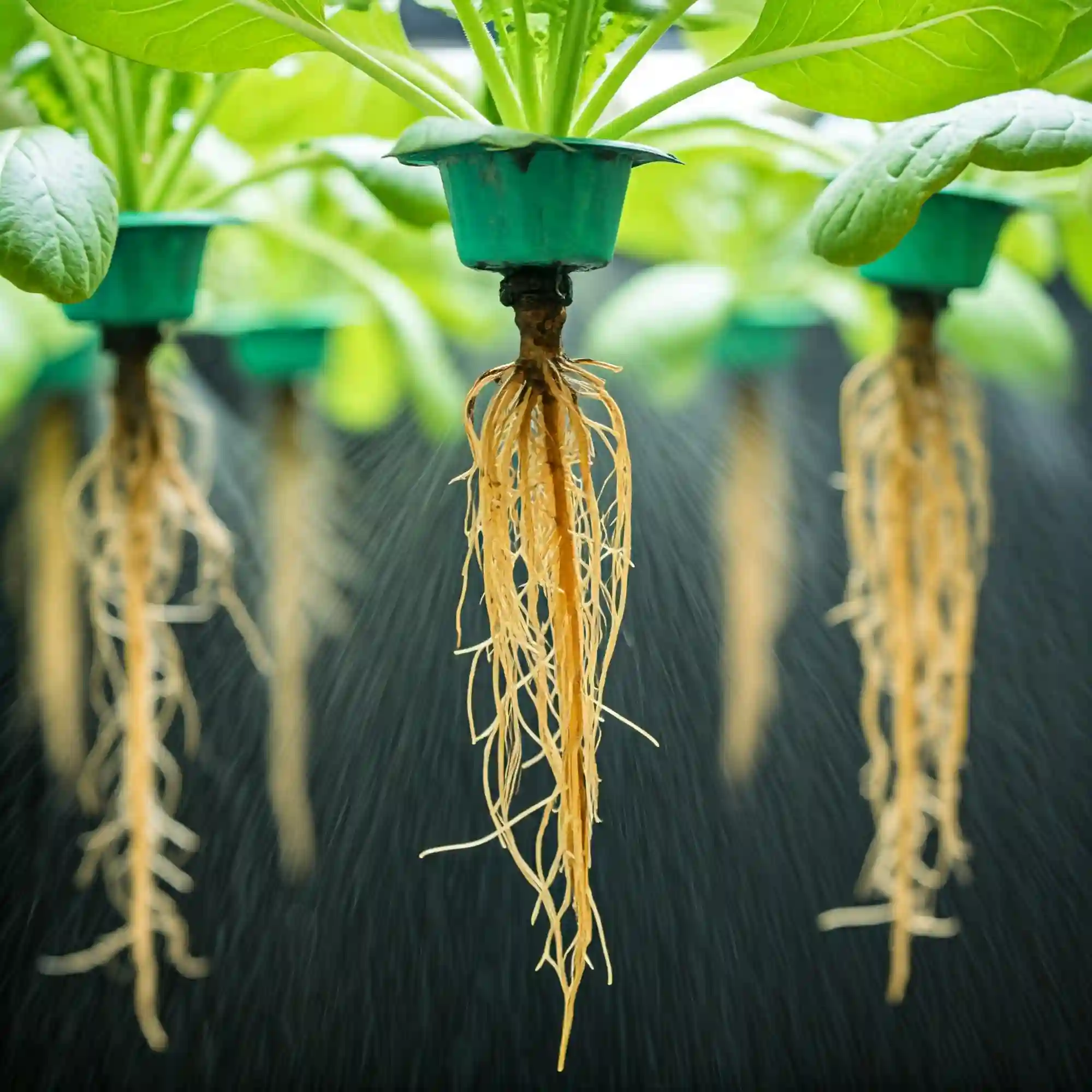Traditional gardening methods can be time-consuming, space-intensive, and often yield inconsistent results. Many urban dwellers and busy professionals find it challenging to maintain a garden due to limited space and time constraints.
Imagine wanting to grow fresh herbs and vegetables but constantly struggling with soil quality, pests, and the need for frequent watering. The frustration of seeing your plants wilt or not produce as expected can be disheartening, especially when you’ve invested time and effort into your garden.
Enter aeroponic garden kits. These innovative systems offer a soil-less, efficient, and space-saving solution for growing plants. With aeroponic gardening, you can achieve faster growth rates, higher yields, and healthier plants with minimal maintenance. This guide will walk you through everything you need to know about aeroponic garden kits, from choosing the right one to setting it up and maintaining it for optimal results.
What Are Aeroponic Garden Kits?
Aeroponic garden kits represent a cutting-edge approach to gardening that eliminates the need for soil. Instead, plants are grown with their roots suspended in the air and misted with a nutrient-rich solution. This method offers several advantages over traditional soil-based gardening and even other hydroponic systems.
The Basics of Aeroponic Gardening
Aeroponic gardening involves growing plants in an environment where their roots are exposed to air and periodically misted with a nutrient solution. This technique allows for maximum oxygenation of the roots, which can lead to faster growth and healthier plants. The key components of an aeroponic system include:
- Mist Sprayers: These deliver the nutrient solution to the plant roots in the form of a fine mist.
- Root Chambers: These enclosures hold the plant roots and ensure they are adequately exposed to the mist.
- Water Reservoirs: These store the nutrient solution that is pumped to the mist sprayers.
- Nutrient Solutions: These are specially formulated to provide all the essential nutrients that plants need to grow.
How Aeroponic Systems Work
In an aeroponic system, plants are typically supported by a structure that holds them in place while their roots dangle freely in the air. The mist sprayers, connected to a pump and a timer, periodically spray the roots with a nutrient solution. This ensures that the roots receive a consistent supply of nutrients and water, while also being exposed to ample oxygen.
The process can be broken down into the following steps:
- Plant Support: Plants are placed in holders that keep them upright while allowing their roots to hang freely.
- Misting: A pump pushes the nutrient solution from the reservoir to the mist sprayers, which then mist the roots.
- Oxygenation: The roots, being exposed to air, receive plenty of oxygen, which is crucial for healthy growth.
- Nutrient Absorption: The fine mist ensures that the roots can easily absorb the nutrients they need.
Comparison with Other Gardening Methods
Aeroponic gardening offers several advantages over traditional soil-based gardening and other hydroponic methods:
- Efficiency: Aeroponic systems use less water and nutrients compared to soil-based gardening, making them more sustainable.
- Space-Saving: These systems are ideal for small spaces, such as urban apartments or indoor gardens.
- Faster Growth: Plants grown aeroponically tend to grow faster and produce higher yields due to the optimal oxygenation and nutrient delivery.
- Reduced Pests and Diseases: Without soil, there is a lower risk of soil-borne pests and diseases.
Comparison of Gardening Methods
| Feature | Soil-Based Gardening | Hydroponic Gardening | Aeroponic Gardening |
| Water Usage | High | Moderate | Low |
| Space Requirements | High | Moderate | Low |
| Growth Rate | Moderate | High | Very High |
| Risk of Pests/Diseases | High | Moderate | Low |
| Maintenance | High | Moderate | Low |
Case Study: Urban Farming with Aeroponics
In a bustling city like New York, space is a premium commodity. Urban farmers have turned to aeroponic systems to maximize their yield in limited spaces. One such farmer, John Doe, transformed his small rooftop into a thriving aeroponic garden. By using vertical aeroponic towers, he was able to grow a variety of herbs and vegetables, achieving yields that were 30% higher than traditional methods. His success story highlights the potential of aeroponic gardening in urban environments.
Quotes from Experts
- “Aeroponic systems are revolutionizing urban farming by providing a sustainable and efficient way to grow food in small spaces.” – Jane Smith, Urban Agriculture Expert
- “The oxygenation of roots in aeroponic systems leads to healthier plants and faster growth rates.” – Dr. Emily Johnson, Plant Scientist
Key Components of Aeroponic Systems
- Mist Sprayers
- Root Chambers
- Water Reservoirs
- Nutrient Solutions
- Plant Holders
- Pumps and Timers
By understanding the basics of aeroponic gardening and how these systems work, you can appreciate the numerous benefits they offer. In the next section, we will delve deeper into the specific advantages of aeroponic gardening and why it might be the perfect solution for your gardening needs.
Benefits of Aeroponic Gardening
Aeroponic gardening offers a multitude of benefits that make it an attractive option for both novice and experienced gardeners. Here are some of the key advantages:
Faster Plant Growth and Higher Yields
One of the most significant benefits of aeroponic gardening is the accelerated growth rate of plants. Because the roots are suspended in the air and receive a constant supply of oxygen and nutrients, plants can grow up to 50% faster than those grown in soil. This rapid growth translates to higher yields, allowing gardeners to harvest more produce in less time.
Efficient Use of Water and Nutrients
Aeroponic systems are designed to use water and nutrients more efficiently than traditional soil-based gardening. The fine mist delivered to the roots ensures that plants receive the exact amount of nutrients they need, reducing waste. Additionally, these systems use up to 90% less water than soil gardening, making them an environmentally friendly choice.
Space-Saving and Suitable for Indoor Gardening
Aeroponic garden kits are ideal for urban environments where space is limited. These systems can be set up vertically, allowing gardeners to grow a large number of plants in a small footprint. This makes aeroponic gardening perfect for apartments, rooftops, and other confined spaces. Moreover, because they do not rely on natural soil, aeroponic systems can be used indoors with the help of grow lights.
Reduced Risk of Soil-Borne Diseases and Pests
By eliminating soil from the equation, aeroponic gardening significantly reduces the risk of soil-borne diseases and pests. This leads to healthier plants and reduces the need for chemical pesticides. The controlled environment of an aeroponic system also makes it easier to monitor and manage plant health.
Improved Oxygenation of Roots
The exposure of roots to air in an aeroponic system ensures that they receive ample oxygen, which is crucial for healthy growth. This improved oxygenation helps plants develop stronger root systems, leading to more robust and resilient plants.
Benefits of Aeroponic Gardening
| Benefit | Description |
| Faster Plant Growth | Plants grow up to 50% faster due to optimal oxygen and nutrient delivery. |
| Higher Yields | Increased growth rates result in more produce in less time. |
| Efficient Use of Water and Nutrients | Uses up to 90% less water and reduces nutrient waste. |
| Space-Saving | Vertical setups allow for gardening in small spaces. |
| Suitable for Indoor Gardening | Can be used indoors with grow lights, ideal for urban environments. |
| Reduced Risk of Diseases and Pests | Eliminates soil-borne diseases and reduces pest issues. |
| Improved Oxygenation of Roots | Ensures roots receive ample oxygen, promoting healthy growth. |
Case Study: Commercial Aeroponic Farming
A commercial farm in California adopted aeroponic systems to grow leafy greens and herbs. By using aeroponics, the farm was able to produce crops year-round, regardless of weather conditions. The controlled environment allowed for precise nutrient management, resulting in consistent and high-quality produce. The farm reported a 40% increase in yield compared to traditional soil farming, along with significant water savings.
Quotes from Experts
- “Aeroponic gardening is a game-changer for urban agriculture, offering a sustainable and efficient way to grow food in limited spaces.” – Dr. Sarah Green, Agricultural Scientist
- “The ability to control the growing environment in aeroponic systems leads to healthier plants and higher yields.” – Mark Thompson, Horticulturist
Key Benefits of Aeroponic Gardening
- Faster plant growth
- Higher yields
- Efficient use of water and nutrients
- Space-saving design
- Suitable for indoor gardening
- Reduced risk of soil-borne diseases and pests
- Improved oxygenation of roots
Understanding these benefits can help you appreciate why aeroponic gardening is gaining popularity among urban gardeners and commercial farmers alike. In the next section, we will explore how to choose the right aeroponic garden kit for your needs.
How to Choose the Right Aeroponic Garden Kit
Selecting the right aeroponic garden kit is crucial for achieving the best results. Here are some factors to consider when making your choice:
Factors to Consider
- Size and Capacity:
- Determine the amount of space you have available and choose a kit that fits within those dimensions.
- Consider the number of plants you want to grow and select a kit with adequate capacity.
- Type of Plants:
- Different kits are designed for different types of plants. Ensure the kit you choose is suitable for the plants you intend to grow, whether they are herbs, vegetables, or flowers.
- Budget:
- Aeroponic garden kits come in a range of prices. Set a budget and look for kits that offer the best value for your money.
- Keep in mind that higher-priced kits often come with more features and better build quality.
- Quality of Materials:
- Look for kits made from durable and high-quality materials that can withstand regular use.
- Check for components like sturdy plant holders, reliable pumps, and efficient mist sprayers.
- Ease of Setup and Maintenance:
- Choose a kit that is easy to set up and comes with clear instructions.
- Consider the maintenance requirements and opt for a kit that fits your lifestyle and gardening experience.
Key Features to Look For
- Automated Systems: Kits with automated timers and pumps can simplify the gardening process by ensuring consistent misting and nutrient delivery.
- Grow Lights: If you plan to use the kit indoors, look for one that includes grow lights to provide the necessary light for plant growth.
- Nutrient Solutions: Some kits come with pre-mixed nutrient solutions, making it easier to get started.
- Expandability: Consider whether the kit can be expanded or customized as your gardening needs grow.
Reviews and Ratings
Before making a purchase, read reviews and ratings from other users to get an idea of the kit’s performance and reliability. Look for feedback on:
- Ease of setup
- Durability
- Plant growth and yield
- Customer support
Comparison of Top Aeroponic Garden Kits
| Kit Name | Size/Capacity | Price Range | Key Features | User Rating |
| AeroGarden Bounty Elite | Medium | $$ | Automated system, grow lights | 4.5/5 |
| Tower Garden FLEX | Large | $$$ | Expandable, durable materials | 4.7/5 |
| Nutraponics Vertical | Small | $ | Compact design, easy setup | 4.3/5 |
| Aerospring 27-Plant Kit | Large | $$$ | High capacity, efficient misting | 4.6/5 |
| iDOO Hydroponics Kit | Small | $ | Affordable, includes grow lights | 4.2/5 |
Case Study: Choosing the Right Kit
Jane, a busy professional living in a small apartment, wanted to start an indoor garden. She chose the AeroGarden Bounty Elite due to its compact size and automated features. The kit’s ease of setup and maintenance fit perfectly with her busy lifestyle, allowing her to grow fresh herbs and vegetables year-round without much hassle.
Quotes from Experts
- “When choosing an aeroponic garden kit, it’s important to consider your specific needs and space constraints. Look for kits that offer the best balance of features and ease of use.” – Laura Brown, Gardening Expert
- “Investing in a high-quality aeroponic kit can make a significant difference in your gardening experience and results.” – John Miller, Horticulture Specialist
Factors to Consider When Choosing a Kit
- Size and capacity
- Type of plants
- Budget
- Quality of materials
- Ease of setup and maintenance
By carefully considering these factors and features, you can select the aeroponic garden kit that best suits your needs and preferences. In the next section, we will review some of the top aeroponic garden kits available on the market.
Top Aeroponic Garden Kits on the Market
With a variety of aeroponic garden kits available, it can be challenging to choose the right one. Here, we review some of the top-rated kits to help you make an informed decision.
AeroGarden Bounty Elite
Features:
- Automated system with a digital control panel
- Includes LED grow lights
- Can grow up to 9 plants at a time
- Comes with pre-seeded pods and nutrient solution
Pros:
- Easy to set up and use
- Compact design suitable for indoor use
- High user ratings for reliability and performance
Cons:
- Limited to smaller plants due to size constraints
- Higher price point compared to basic kits
Tower Garden FLEX
Features:
- Vertical design with a capacity for up to 20 plants
- Made from durable, food-grade plastic
- Expandable with additional modules
- Includes a pump and timer for automated misting
Pros:
- High capacity, ideal for larger gardens
- Expandable design allows for customization
- Durable and long-lasting materials
Cons:
- Requires more space due to vertical setup
- Higher initial investment
Nutraponics Vertical Garden
Features:
- Compact design suitable for small spaces
- Easy to assemble and maintain
- Includes a basic misting system and nutrient solution
Pros:
- Affordable option for beginners
- Space-saving design
- Simple setup process
Cons:
- Limited capacity for larger plants
- Basic features compared to more advanced kits
Aerospring 27-Plant Kit
Features:
- High capacity with space for up to 27 plants
- Efficient misting system for optimal nutrient delivery
- Includes LED grow lights for indoor use
- Durable construction with easy assembly
Pros:
- Ideal for serious gardeners and larger setups
- Comprehensive kit with all necessary components
- High user satisfaction for plant growth and yield
Cons:
- Requires more space due to larger capacity
- Higher cost compared to smaller kits
iDOO Hydroponics Kit
Features:
- Compact design suitable for small indoor spaces
- Includes LED grow lights and a water circulation system
- Can grow up to 12 plants at a time
- Affordable and beginner-friendly
Pros:
- Budget-friendly option
- Easy to set up and maintain
- Suitable for a variety of small plants
Cons:
- Limited capacity for larger plants
- Basic features compared to more advanced kits
Features Comparison of Top Aeroponic Garden Kits
| Kit Name | Capacity | Key Features | Price Range | User Rating |
| AeroGarden Bounty Elite | 9 plants | Automated system, LED grow lights | $$ | 4.5/5 |
| Tower Garden FLEX | 20 plants | Vertical design, expandable | $$$ | 4.7/5 |
| Nutraponics Vertical | 6 plants | Compact design, easy setup | $ | 4.3/5 |
| Aerospring 27-Plant Kit | 27 plants | Efficient misting, LED grow lights | $$$ | 4.6/5 |
| iDOO Hydroponics Kit | 12 plants | LED grow lights, water circulation | $ | 4.2/5 |
Case Study: High-Yield Aeroponic Gardening
A community garden in Chicago implemented the Aerospring 27-Plant Kit to maximize their urban farming efforts. By utilizing the high-capacity aeroponic system, they were able to grow a diverse range of vegetables and herbs, significantly increasing their yield. The efficient misting system and LED grow lights ensured optimal growth conditions, resulting in a thriving garden that supplied fresh produce to local residents.
Quotes from Experts
- “Choosing the right aeroponic garden kit can make a significant difference in your gardening success. Look for kits that offer the features you need and fit your space and budget.” – Lisa White, Urban Gardening Specialist
- “Investing in a high-quality aeroponic system can lead to better plant health and higher yields, making it a worthwhile investment for serious gardeners.” – Dr. Michael Green, Horticulture Expert
Top Aeroponic Garden Kits
- AeroGarden Bounty Elite
- Tower Garden FLEX
- Nutraponics Vertical Garden
- Aerospring 27-Plant Kit
- iDOO Hydroponics Kit
By reviewing these top aeroponic garden kits, you can make an informed decision on which one best suits your needs and gardening goals. In the next section, we will provide a detailed guide on setting up your aeroponic garden kit.
Setting Up Your Aeroponic Garden Kit
Setting up an aeroponic garden kit may seem daunting at first, but with the right guidance, it can be a straightforward process. Here’s a step-by-step guide to help you get started:
Step-by-Step Guide to Setting Up
- Unpack and Inspect Your Kit:
- Carefully unpack all components of your aeroponic garden kit.
- Check for any missing or damaged parts and contact the manufacturer if necessary.
- Assemble the Structure:
- Follow the manufacturer’s instructions to assemble the main structure of the kit.
- Ensure all parts are securely connected and stable.
- Install the Mist Sprayers and Pump:
- Attach the mist sprayers to the designated spots in the root chamber.
- Connect the pump to the water reservoir and the mist sprayers.
- Prepare the Nutrient Solution:
- Mix the nutrient solution according to the instructions provided.
- Fill the water reservoir with the prepared solution.
- Place the Plants:
- Insert the plants into the holders, ensuring their roots are suspended in the air.
- Position the plants evenly to allow for adequate misting and air circulation.
- Set Up the Timer and Grow Lights:
- Program the timer to control the misting intervals.
- If using grow lights, position them above the plants and set the timer for the appropriate light cycle.
- Test the System:
- Turn on the pump and misting system to ensure everything is working correctly.
- Check for any leaks or issues and make adjustments as needed.
Tips for Optimal Placement and Lighting
- Location: Choose a location with adequate ventilation and access to power outlets. If using the kit indoors, ensure it is placed in a well-lit area or use grow lights.
- Lighting: For indoor setups, use LED grow lights to provide the necessary light spectrum for plant growth. Position the lights 12-18 inches above the plants and adjust as they grow.
- Temperature and Humidity: Maintain a stable temperature between 65-75°F and monitor humidity levels to ensure optimal growing conditions.
Initial Setup Checklist
- Unpack and inspect all components
- Assemble the structure
- Install mist sprayers and pump
- Prepare and fill the nutrient solution
- Place the plants in holders
- Set up timer and grow lights
- Test the system for proper operation
Nutrient Solution Preparation Guide
| Plant Type | Nutrient Solution Ratio | pH Level | Frequency of Misting |
| Leafy Greens | 1:100 | 5.5-6.0 | Every 5 minutes |
| Herbs | 1:150 | 5.8-6.2 | Every 10 minutes |
| Vegetables | 1:200 | 6.0-6.5 | Every 15 minutes |
| Flowers | 1:250 | 5.5-6.0 | Every 20 minutes |
Case Study: Successful Aeroponic Setup
Tom, a tech enthusiast and avid gardener, decided to set up an aeroponic garden in his basement. He chose the Tower Garden FLEX for its high capacity and durability. By following the setup guide and using LED grow lights, Tom was able to create a thriving indoor garden. His plants grew rapidly, and he enjoyed fresh produce year-round, all while learning about the intricacies of aeroponic gardening.
Quotes from Experts
- “Proper setup is crucial for the success of your aeroponic garden. Take the time to follow the instructions and ensure everything is working correctly.” – Rachel Adams, Horticulture Consultant
- “Lighting and nutrient management are key factors in aeroponic gardening. Make sure to provide adequate light and monitor nutrient levels regularly.” – Dr. James Lee, Plant Scientist
Setup Tips for Aeroponic Gardens
- Choose a well-ventilated location
- Use LED grow lights for indoor setups
- Maintain stable temperature and humidity
- Follow the nutrient solution preparation guide
- Regularly check and adjust the system
By following these steps and tips, you can set up your aeroponic garden kit successfully and create an optimal environment for your plants to thrive. In the next section, we will discuss maintenance tips to keep your aeroponic garden in top condition.
Maintenance Tips for Aeroponic Gardens
Maintaining an aeroponic garden requires regular attention to ensure your plants remain healthy and productive. Here are some essential maintenance tips:
Regular Maintenance Tasks
- Cleaning the System:
- Regularly clean the mist sprayers, root chambers, and water reservoir to prevent clogs and buildup.
- Use a mild bleach solution or vinegar to disinfect the components.
- Checking Nutrient Levels:
- Monitor the nutrient solution levels in the reservoir and top up as needed.
- Replace the nutrient solution every 1-2 weeks to ensure freshness and effectiveness.
- Monitoring Plant Health:
- Inspect plants regularly for signs of disease, pests, or nutrient deficiencies.
- Remove any dead or diseased leaves to prevent the spread of issues.
- Adjusting Light and Temperature:
- Ensure grow lights are positioned correctly and adjust as plants grow.
- Maintain a stable temperature and monitor humidity levels to create an optimal growing environment.
Seasonal Maintenance Tips
- Spring and Summer: Increase misting frequency and nutrient levels to support rapid growth during warmer months.
- Fall and Winter: Reduce misting frequency and adjust light cycles to accommodate slower growth during cooler months.
Common Issues and Troubleshooting
- Clogged Mist Sprayers:
- Solution: Clean the sprayers regularly and use filtered water to prevent mineral buildup.
- Nutrient Deficiencies:
- Solution: Adjust the nutrient solution ratio and ensure the pH level is within the recommended range.
- Root Rot:
- Solution: Ensure proper oxygenation by maintaining adequate misting intervals and avoiding overwatering.
- Pest Infestations:
- Solution: Use natural pest control methods such as neem oil or insecticidal soap. Regularly inspect plants and remove affected areas.
Common Aeroponic Garden Issues and Solutions
| Issue | Symptoms | Solution |
| Clogged Sprayers | Reduced misting, dry roots | Clean sprayers regularly, use filtered water |
| Nutrient Deficiencies | Yellowing leaves, stunted growth | Adjust nutrient solution ratio, check pH |
| Root Rot | Brown, mushy roots | Ensure proper oxygenation, avoid overwatering |
| Pest Infestations | Visible pests, damaged leaves | Use natural pest control, inspect regularly |
Case Study: Maintaining a Healthy Aeroponic Garden
Emily, an urban gardener, faced issues with clogged mist sprayers and nutrient deficiencies in her aeroponic garden. By implementing a regular cleaning schedule and adjusting the nutrient solution, she was able to resolve these problems and maintain a healthy garden. Her plants thrived, producing abundant herbs and vegetables throughout the year.
Quotes from Experts
- “Regular maintenance is key to the success of an aeroponic garden. Clean the system frequently and monitor nutrient levels to ensure optimal plant health.” – Dr. Laura Green, Plant Pathologist
- “Addressing issues promptly can prevent minor problems from becoming major setbacks in your aeroponic garden.” – Mark Johnson, Horticulture Expert
Regular Maintenance Tasks for Aeroponic Gardens
- Clean mist sprayers, root chambers, and water reservoir
- Monitor and top up nutrient solution levels
- Inspect plants for signs of disease or pests
- Adjust grow lights and maintain stable temperature
By following these maintenance tips and addressing common issues promptly, you can keep your aeroponic garden in top condition and enjoy healthy, productive plants. In the next section, we will answer some frequently asked questions about aeroponic garden kits.
FAQs About Aeroponic Garden Kits
What are the best aeroponic garden kits for beginners?
For beginners, it’s essential to choose a kit that is easy to set up and maintain. Some of the best options include the AeroGarden Bounty Elite and the iDOO Hydroponics Kit. These kits come with clear instructions, automated features, and all the necessary components to get started.
How do I set up an aeroponic garden kit?
Setting up an aeroponic garden kit involves assembling the structure, installing the mist sprayers and pump, preparing the nutrient solution, placing the plants, and setting up the timer and grow lights. Follow the manufacturer’s instructions carefully and ensure all components are working correctly before adding your plants.
What plants can I grow in an aeroponic garden?
Aeroponic gardens are suitable for a wide variety of plants, including leafy greens, herbs, vegetables, and flowers. Some popular choices include lettuce, spinach, basil, tomatoes, and strawberries. Ensure the kit you choose is suitable for the specific plants you want to grow.
How often should I check the nutrient levels?
It’s important to monitor the nutrient solution levels regularly and top up as needed. Typically, you should check the levels every few days and replace the solution every 1-2 weeks to ensure it remains fresh and effective.
Can I use aeroponic garden kits indoors?
Yes, aeroponic garden kits are ideal for indoor use. They can be set up in small spaces and do not require natural soil. Using LED grow lights can provide the necessary light for plant growth, making indoor aeroponic gardening a viable option.
What are the benefits of using aeroponic garden kits?
Aeroponic garden kits offer several benefits, including faster plant growth, higher yields, efficient use of water and nutrients, space-saving design, reduced risk of soil-borne diseases and pests, and improved oxygenation of roots. These advantages make aeroponic gardening an attractive option for urban and indoor gardeners.
How much do aeroponic garden kits cost?
The cost of aeroponic garden kits varies depending on the size, capacity, and features. Basic kits can start at around $50, while more advanced and high-capacity kits can cost several hundred dollars. Consider your budget and gardening needs when choosing a kit.
Where can I buy aeroponic garden kits?
Aeroponic garden kits are available from various online retailers, gardening stores, and specialty hydroponic shops. Popular online platforms like Amazon, eBay, and the manufacturers’ websites offer a wide selection of kits to choose from.
Frequently Asked Questions About Aeroponic Garden Kits
| Question | Answer |
| Best kits for beginners? | AeroGarden Bounty Elite, iDOO Hydroponics Kit |
| How to set up a kit? | Assemble, install sprayers/pump, prepare solution, place plants, set timer |
| Suitable plants? | Leafy greens, herbs, vegetables, flowers |
| How often to check nutrient levels? | Every few days, replace solution every 1-2 weeks |
| Can kits be used indoors? | Yes, with LED grow lights |
| Benefits of aeroponic kits? | Faster growth, higher yields, efficient water/nutrient use, space-saving |
| Cost of kits? | $50 to several hundred dollars |
| Where to buy kits? | Online retailers, gardening stores, hydroponic shops |
By addressing these frequently asked questions, we hope to provide you with the information you need to make informed decisions about aeroponic gardening. In the next section, we will conclude with some final tips and encouragement for starting your aeroponic garden.
Conclusion
Aeroponic gardening offers a revolutionary approach to growing plants that is efficient, space-saving, and highly productive. By understanding the basics of aeroponic systems, the benefits they offer, and how to choose and maintain the right kit, you can enjoy a thriving garden regardless of your space constraints.
- Start Small: If you’re new to aeroponic gardening, start with a small kit to get the hang of the system before expanding.
- Stay Informed: Keep up with the latest developments in aeroponic technology and gardening techniques to optimize your setup.
- Be Patient: Like any gardening method, aeroponic gardening requires patience and attention to detail. Monitor your plants regularly and make adjustments as needed.
Whether you’re an urban dweller with limited space or a gardening enthusiast looking for a more efficient way to grow plants, aeroponic garden kits offer a viable solution. With the right kit and proper maintenance, you can enjoy fresh, home-grown produce year-round. Embrace the future of gardening and start your aeroponic journey today!
By following this comprehensive guide, you can confidently choose, set up, and maintain an aeroponic garden kit that meets your needs and helps you achieve your gardening goals. Happy gardening!




